Riparian areas and wetlands occupy less than 4% of Montana’s land area, yet they are used by more than 80% of the bird species found in Montana and 75% of all vertebrates. Cottonwood riparian forests are especially important: no other habitat supports a higher diversity of breeding birds, and many species that breed in other habitats forage in cottonwoods during migration. So what happens when riparian habitats are converted to cropland or degraded by heavy grazing or logging or weeds? Explore the impacts of human activities by moving through the slides below.
Riparian Cover: Stream Productivity
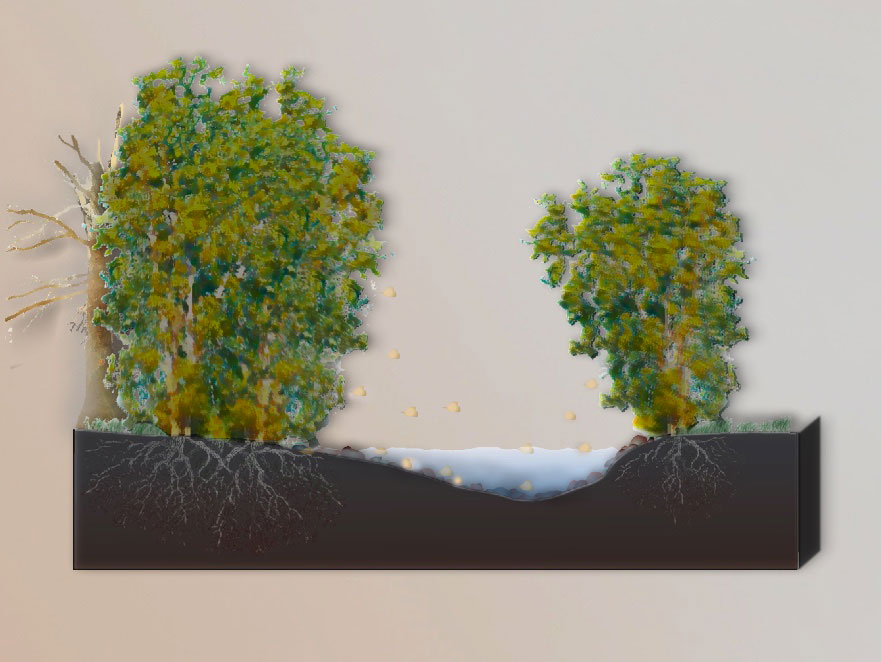
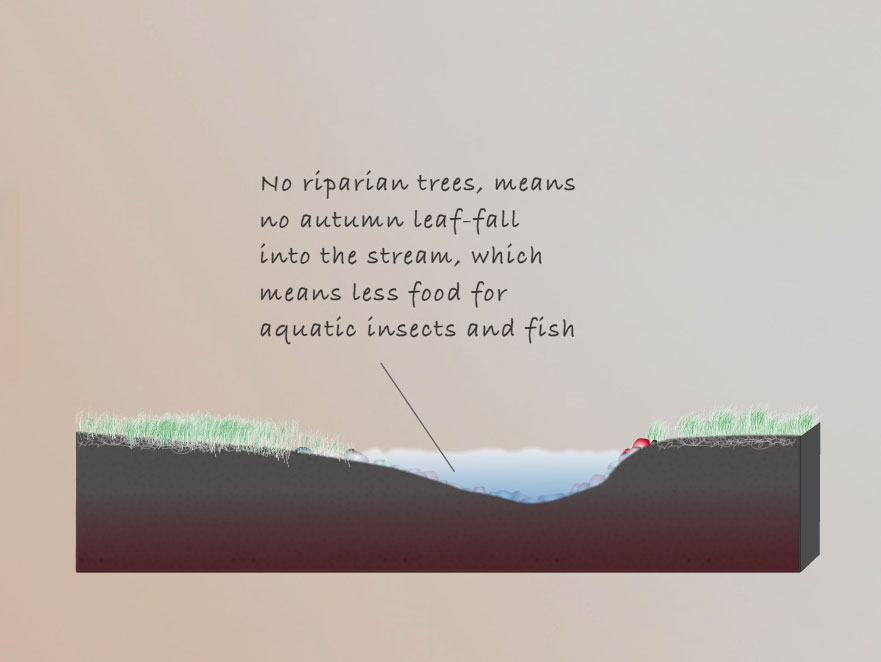
Use the bubbles to navigate between a stream with riparian cover and one without
During autumn, leaves drop into the stream. As they decompose, they are fed upon by aquatic insects. They, in turn, are the most important food source for fish and riparian birds. So a healthy riparian zone adds immensely to the productivity of the stream.
Leaves also fertilize the floodplain. As they fall and decompose, they release carbon, nitrogen, and other chemicals that nourish the soil and that tree roots can assimilate the following season.
Riparian vegetation supplies energy in the form of leaf litter and other organic debris, which is at the foundation of the aquatic food web.
When a riparian forest is converted to agricultural cropland or removed for other reasons, there is no autumn leaf drop, and that means a lot less food for aquatic insects and ultimately for fish and birds.
Riparian Cover: Stream Stability
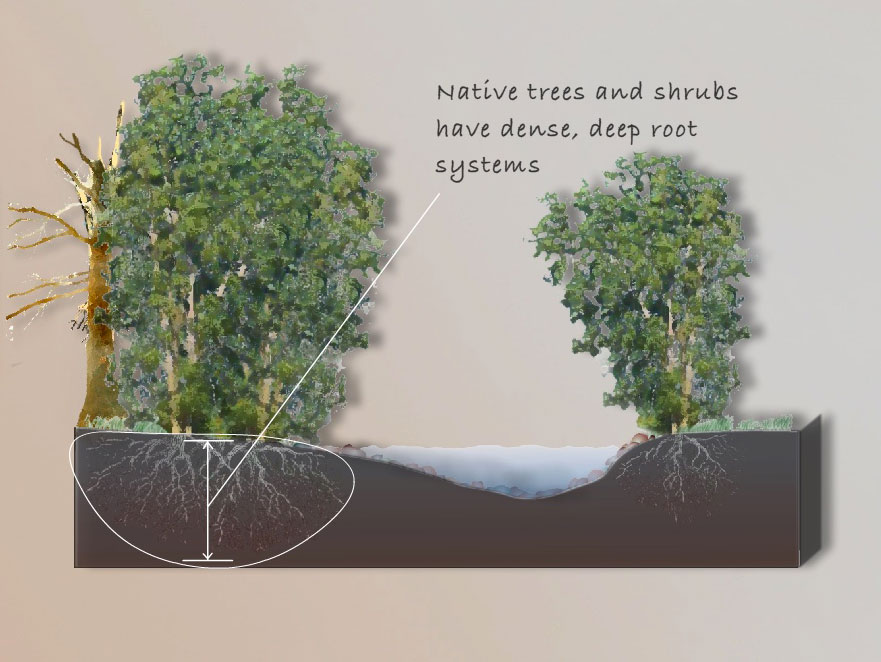
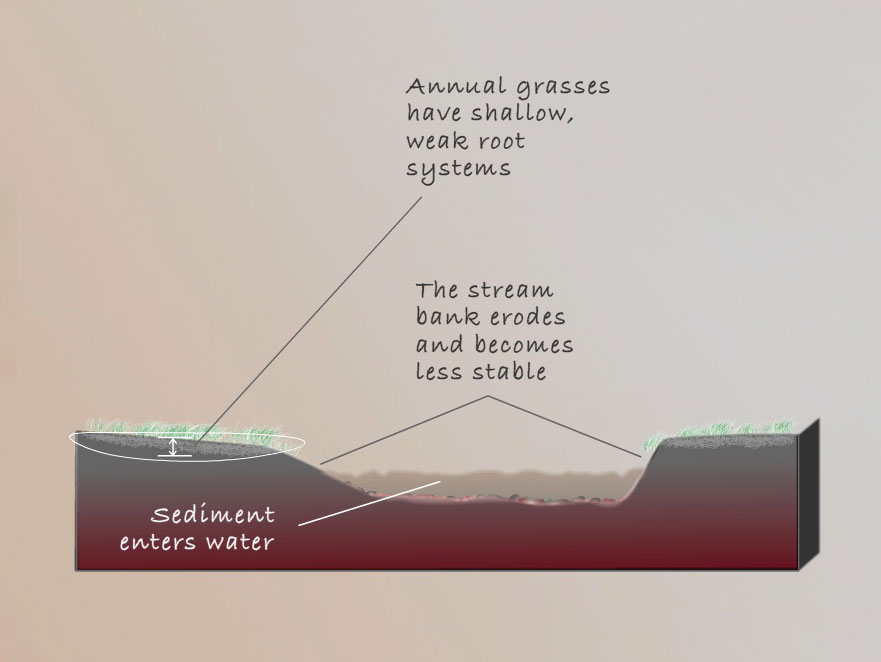
Use the bubbles to navigate between a stream with riparian cover and one without
Riparian vegetation is the most critical component of channel stability. The com-bined root masses of riparian trees, shrubs, forbs, and grasses are exceptionally strong and dense. Think of them as "riparian rebar". They work together to form a tight mesh that reinforces and holds stream banks.
Roots also increase the roughness of the channel, helping to dissipate the energy of floodwaters and catching and trapping sedi-ment so it does not fill downstream pools.
The loss of riparian forest cover means there are no roots to stabilize the stream bank, and that can result in erosion or downcutting—the stream cutting its way deeper into the bed and releasing sediment into the stream. The channel becomes less stable, and the increased fine sediment levels in the stream hurt trout spawning habitats by clogging streambed gravels. The sediment also fills in pools, and lowers aquatic insect production.
Riparian Cover: Water Temperature
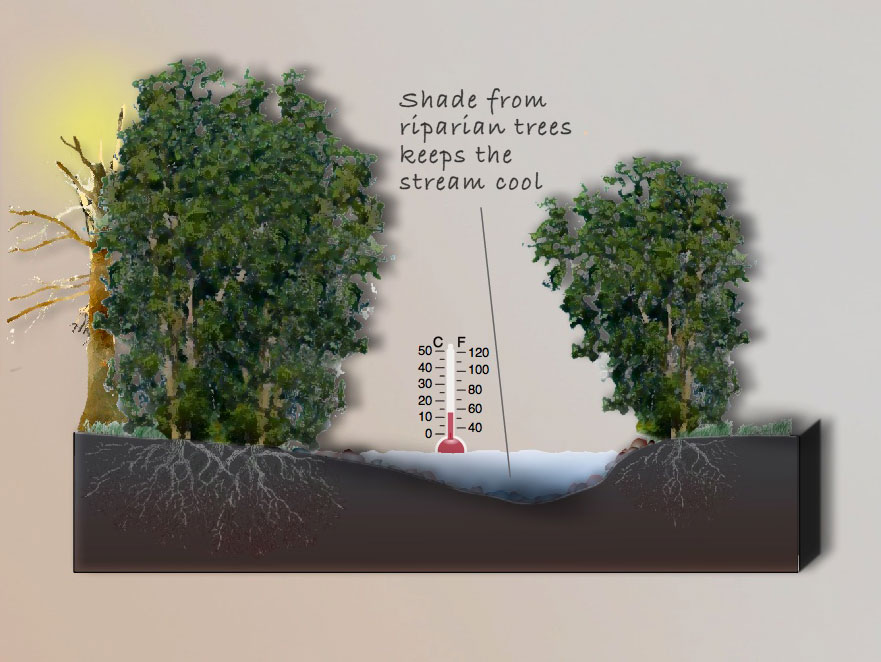
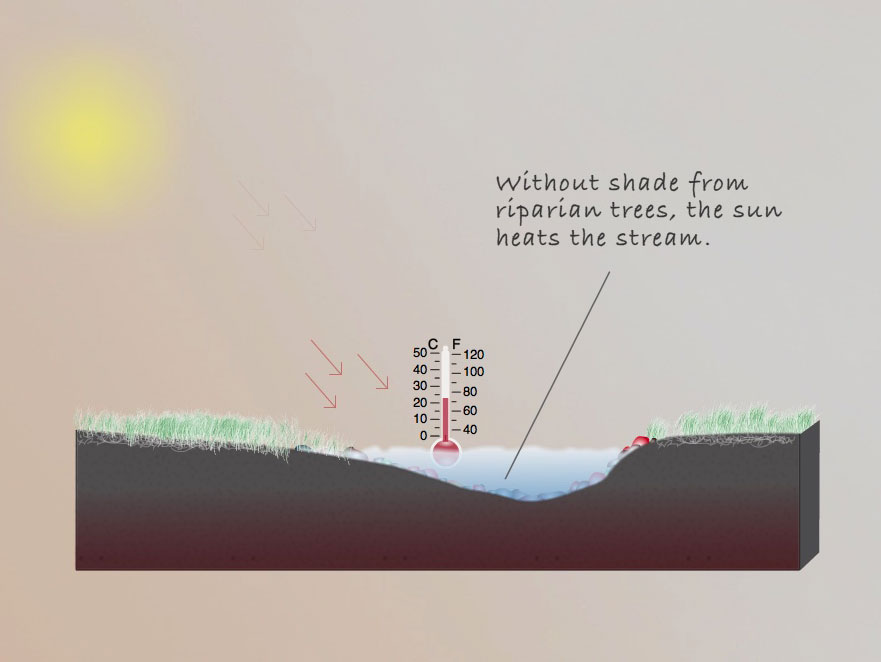
Use the bubbles to navigate between a stream with riparian cover and one without
The shade provided by riparian trees moderates local air and water temperatures and significantly reduces peak summer temperatures within the stream. Bull trout require cold water; they cannot tolerate maximum summertime water temperatures above 15° C (59° F).
Riparian forests will have an increasingly important role to play in limiting the effects of global warming on fish.
Increases in direct solar radiation caused by the reduction or loss of riparian vegetation is the single factor most responsible for high stream temperatures.
Fish biologists think the Jocko River is probably 5 to 10° F warmer today than it was in the late 1800s. Much of that increase is due to the loss of substantial areas of streamside riparian vegetation, trees and shrubs that once shaded the river.
Riparian Cover: Habitat
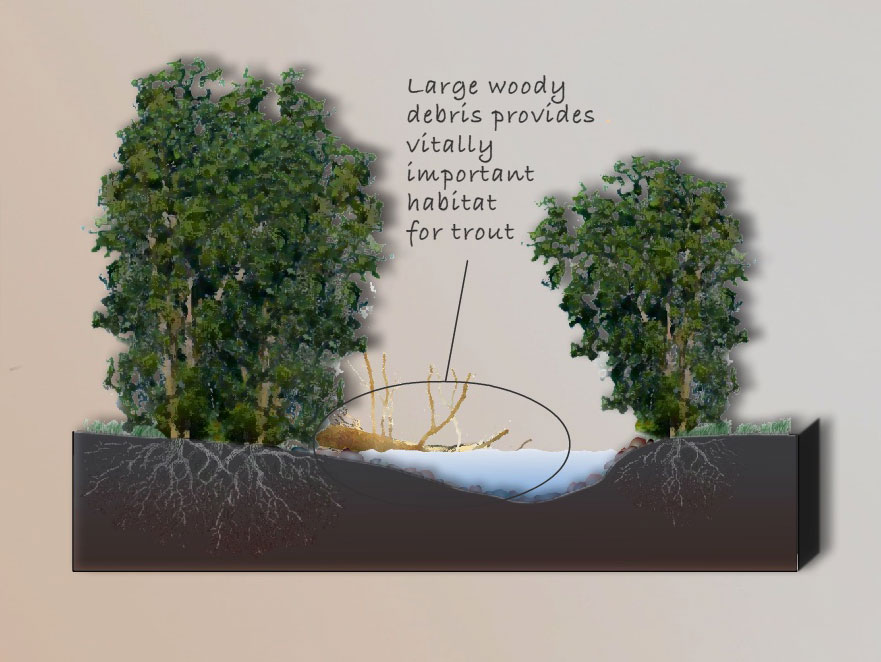

Use the bubbles to navigate between a stream with riparian cover and one without
Riparian areas provide a variety of important habitats for trout. Perhaps most important, they contribute large woody debris (logs) to the stream, which provides resting, hiding, and feeding areas for native fish. Tree roots of both standing and downed trees also provide important cover for juvenile trout.
In addition, riparian areas provide important habitat for birds and mammals. Three quarters of species in Montana use riparian habitats.
The removal of trees from riparian areas eliminates the source of large woody debris, which is essential to maintaining habitat complexity and productivity.
Grazing and trampling of vegetation by livestock can also damage habitats for fish and wildlife. The result is often wide, open channels with lower, warmer, and more turbid flows in summer; damaging ice conditions in winter; and flashier, more turbid flows during high-water periods in spring.
Riparian Cover: Water Quality
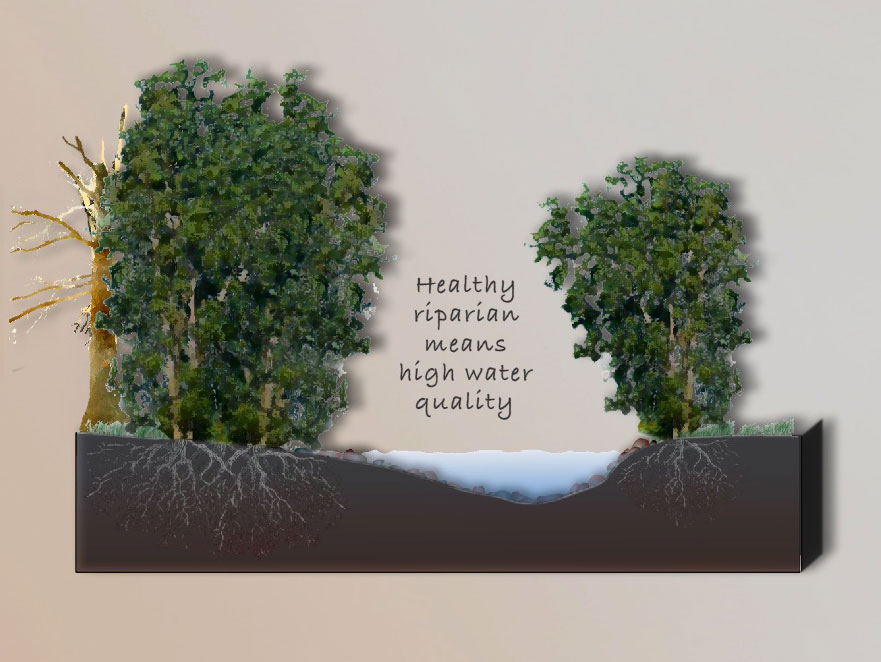
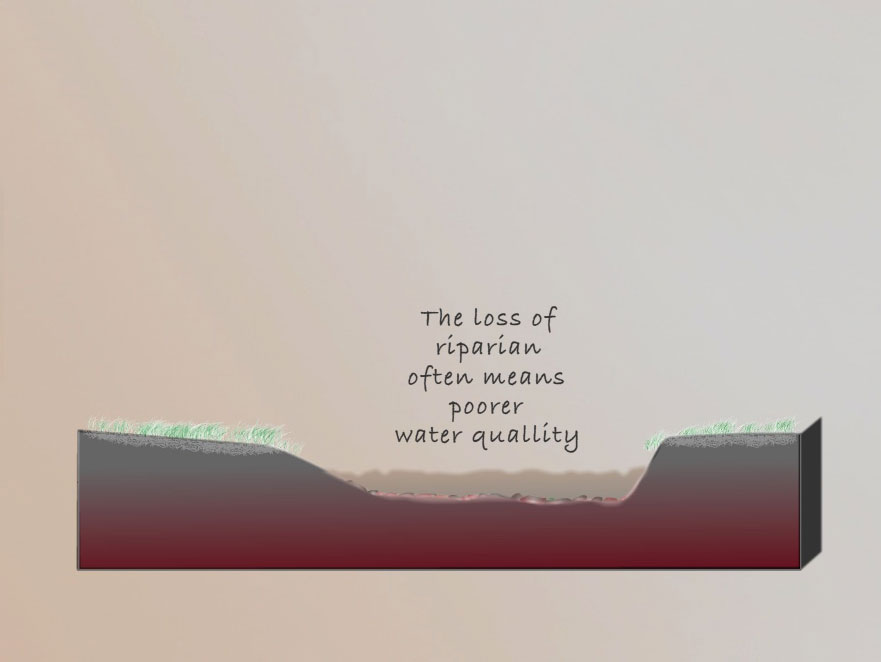
Use the bubbles to navigate between a stream with riparian cover and one without
Riparian areas protect water quality by capturing, storing, and treating water through their soils before it gets to the stream. Healthy growing plants take up nutrients transported into the riparian areas, and organic matter that drops from the riparian canopy onto the floodplain helps to capture contaminants and facilitate their breakdown.
Removing or reducing riparian cover by grazing, logging, or conversion to agricultural land will often lower the water quality of a stream. The effects of grazing can include trampling and sloughing of streambanks, loss of over-hanging banks, accelerated bank erosion, compaction of soils, and increased sediment input. Farming can increase erosion and sedimentation processes many-fold over natural rates. Logging can cause rapid changes in flow, increase peak flows, and increase sediment load (because the channel is less stable and eroding).
Riparian areas and wetlands occupy less than 4% of Montana’s land area, yet they are used by more than 80% of the bird species found in Montana and 75% of all vertebrates. Cottonwood riparian forests are especially important: no other habitat supports a higher diversity of breeding birds, and many species that breed in other habitats forage in cottonwoods during migration. So what happens when riparian habitats are converted to cropland or degraded by heavy grazing or logging or weeds? Explore the impacts of human activities by moving through the slides below.
Riparian Cover: Stream Productivity
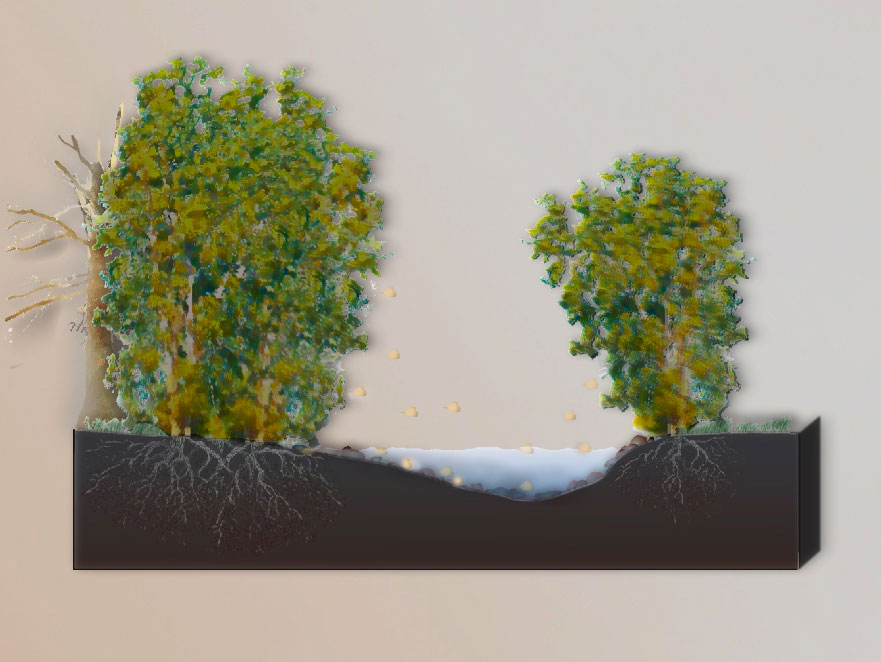
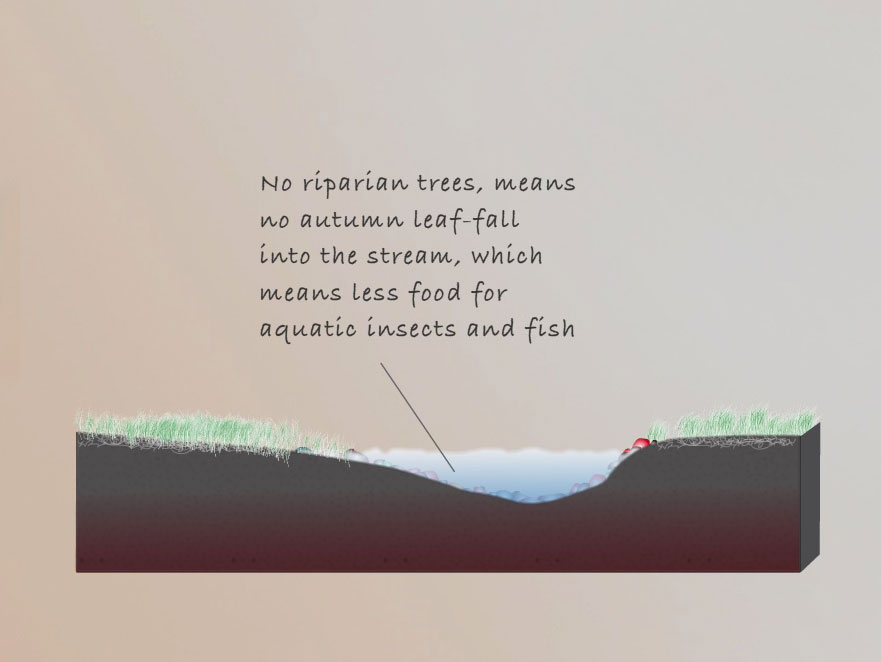
Use the bubbles to navigate between a stream with riparian cover and one without
During autumn, leaves drop into the stream. As they decompose, they are fed upon by aquatic insects. They, in turn, are the most important food source for fish and riparian birds. So a healthy riparian zone adds immensely to the productivity of the stream.
Leaves also fertilize the floodplain. As they fall and decompose, they release carbon, nitrogen, and other chemicals that nourish the soil and that tree roots can assimilate the following season.
Riparian vegetation supplies energy in the form of leaf litter and other organic debris, which is at the foundation of the aquatic food web.
When a riparian forest is converted to agricultural cropland or removed for other reasons, there is no autumn leaf drop, and that means a lot less food for aquatic insects and ultimately for fish and birds.
Riparian Cover: Stream Stability
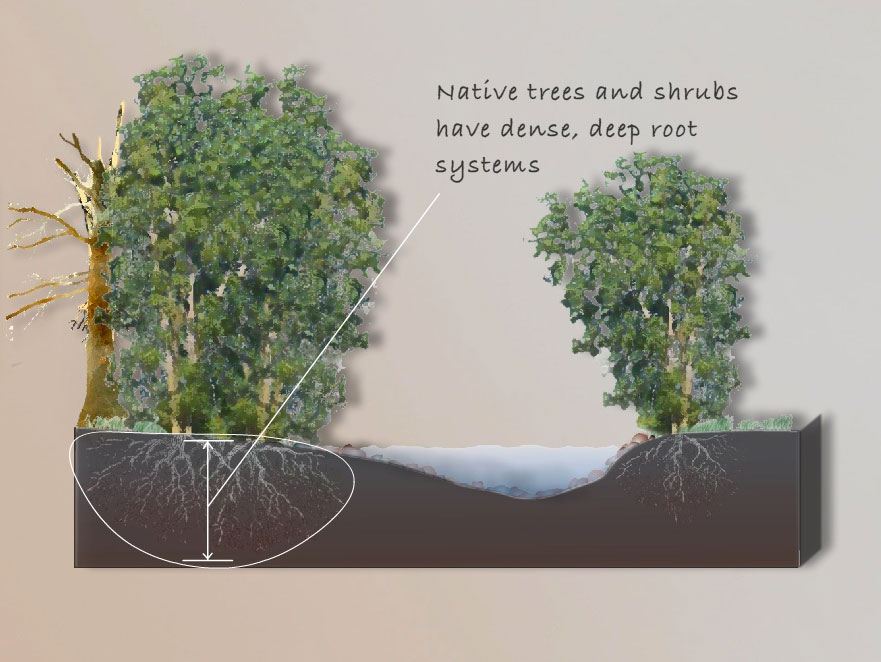
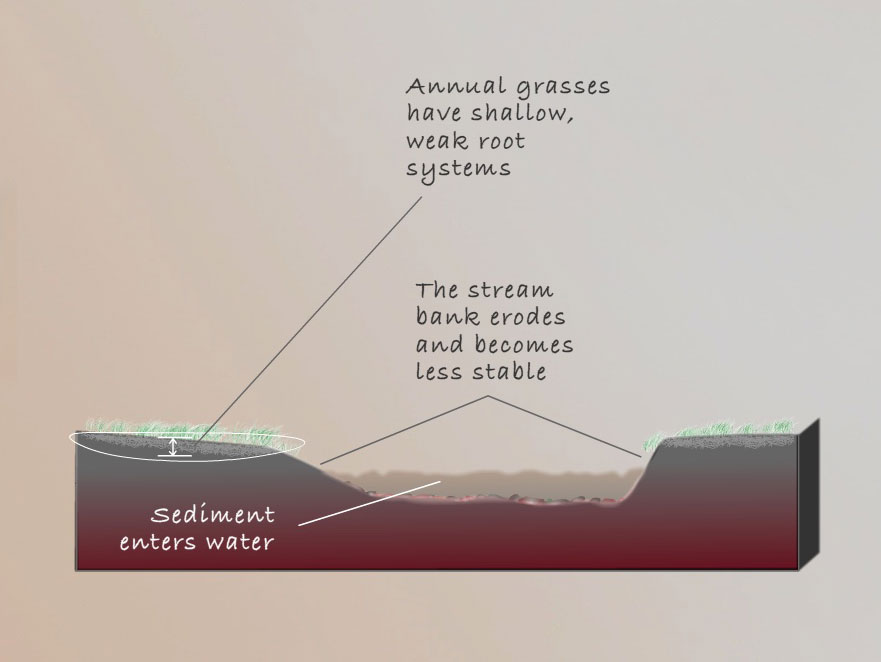
Use the bubbles to navigate between a stream with riparian cover and one without
Riparian vegetation is the most critical component of channel stability. The com-bined root masses of riparian trees, shrubs, forbs, and grasses are exceptionally strong and dense. Think of them as "riparian rebar". They work together to form a tight mesh that reinforces and holds stream banks.
Roots also increase the roughness of the channel, helping to dissipate the energy of floodwaters and catching and trapping sedi-ment so it does not fill downstream pools.
The loss of riparian forest cover means there are no roots to stabilize the stream bank, and that can result in erosion or downcutting—the stream cutting its way deeper into the bed and releasing sediment into the stream. The channel becomes less stable, and the increased fine sediment levels in the stream hurt trout spawning habitats by clogging streambed gravels. The sediment also fills in pools, and lowers aquatic insect production.
Riparian Cover: Water Temperature
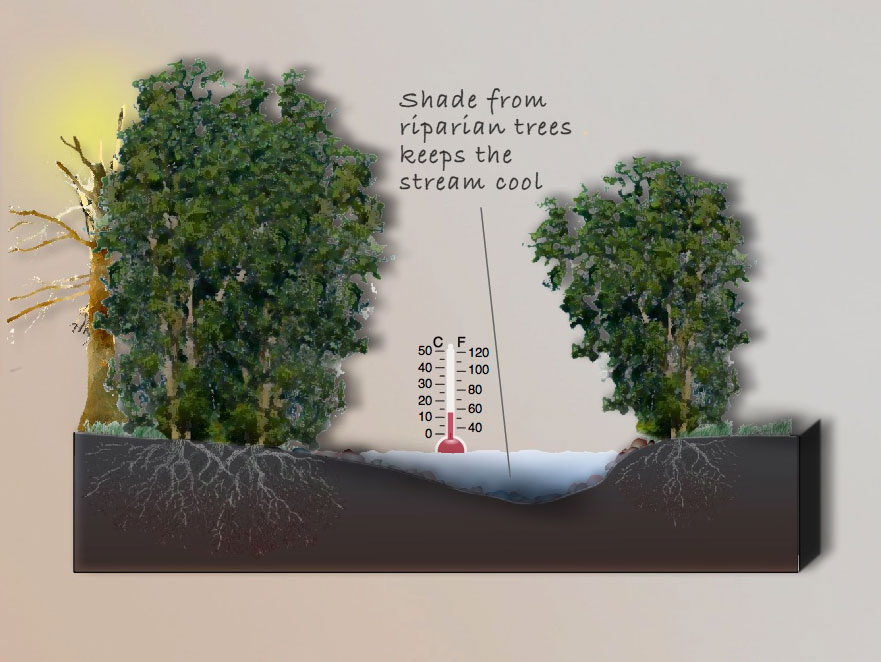
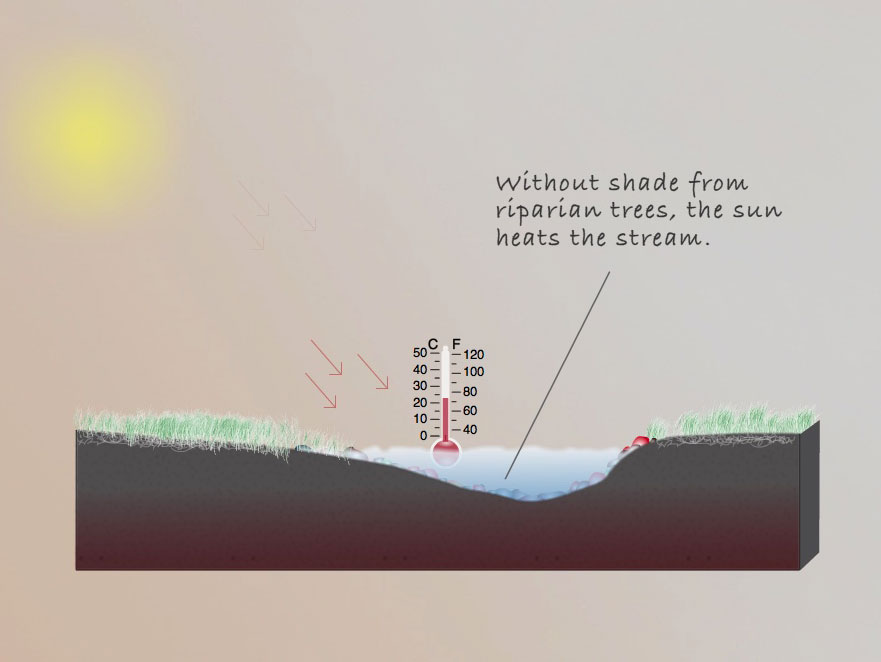
Use the bubbles to navigate between a stream with riparian cover and one without
The shade provided by riparian trees moderates local air and water temperatures and significantly reduces peak summer temperatures within the stream. Bull trout require cold water; they cannot tolerate maximum summertime water temperatures above 15° C (59° F).
Riparian forests will have an increasingly important role to play in limiting the effects of global warming on fish.
Increases in direct solar radiation caused by the reduction or loss of riparian vegetation is the single factor most responsible for high stream temperatures.
Fish biologists think the Jocko River is probably 5 to 10° F warmer today than it was in the late 1800s. Much of that increase is due to the loss of substantial areas of streamside riparian vegetation, trees and shrubs that once shaded the river.
Riparian Cover: Habitat
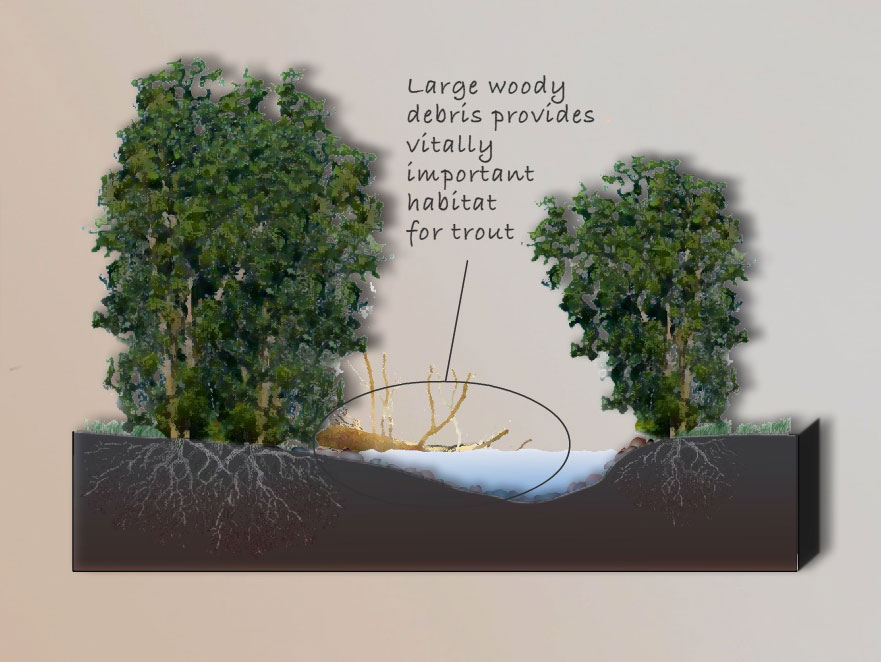
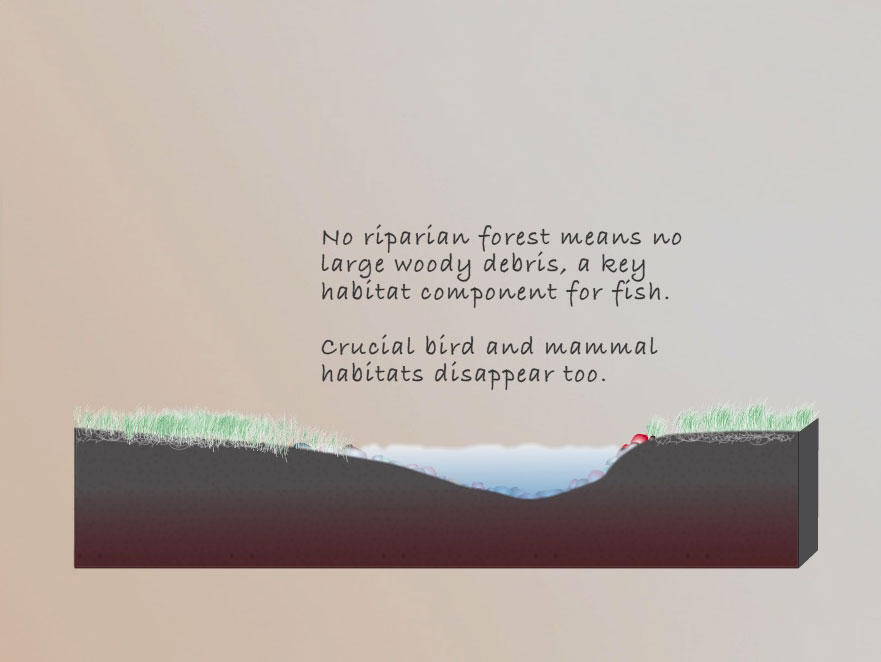
Use the bubbles to navigate between a stream with riparian cover and one without
Riparian areas provide a variety of important habitats for trout. Perhaps most important, they contribute large woody debris (logs) to the stream, which provides resting, hiding, and feeding areas for native fish. Tree roots of both standing and downed trees also provide important cover for juvenile trout.
In addition, riparian areas provide important habitat for birds and mammals. Three quarters of species in Montana use riparian habitats.
The removal of trees from riparian areas eliminates the source of large woody debris, which is essential to maintaining habitat complexity and productivity.
Grazing and trampling of vegetation by livestock can also damage habitats for fish and wildlife. The result is often wide, open channels with lower, warmer, and more turbid flows in summer; damaging ice conditions in winter; and flashier, more turbid flows during high-water periods in spring.
Riparian Cover: Water Quality
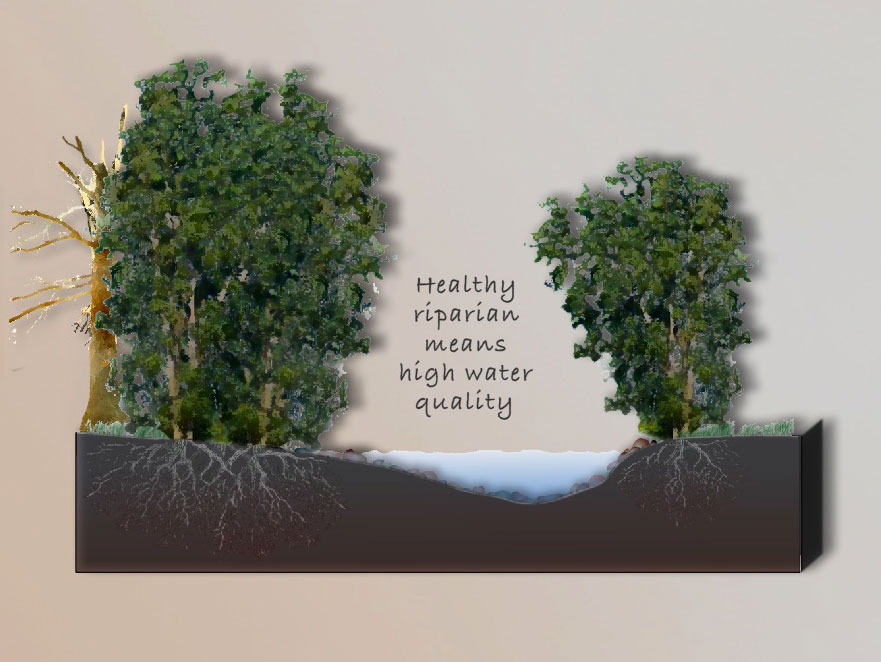

Use the bubbles to navigate between a stream with riparian cover and one without
Riparian areas protect water quality by capturing, storing, and treating water through their soils before it gets to the stream. Healthy growing plants take up nutrients transported into the riparian areas, and organic matter that drops from the riparian canopy onto the floodplain helps to capture contaminants and facilitate their breakdown.
Removing or reducing riparian cover by grazing, logging, or conversion to agricultural land will often lower the water quality of a stream. The effects of grazing can include trampling and sloughing of streambanks, loss of over-hanging banks, accelerated bank erosion, compaction of soils, and increased sediment input. Farming can increase erosion and sedimentation processes many-fold over natural rates. Logging can cause rapid changes in flow, increase peak flows, and increase sediment load (because the channel is less stable and eroding).
Riparian areas and wetlands occupy less than 4% of Montana’s land area, yet they are used by more than 80% of the bird species found in Montana and 75% of all vertebrates. So what happens when riparian habitats are converted to cropland or degraded? Explore the impacts of human activities by moving through the slides below.
Riparian Cover: Stream Productivity

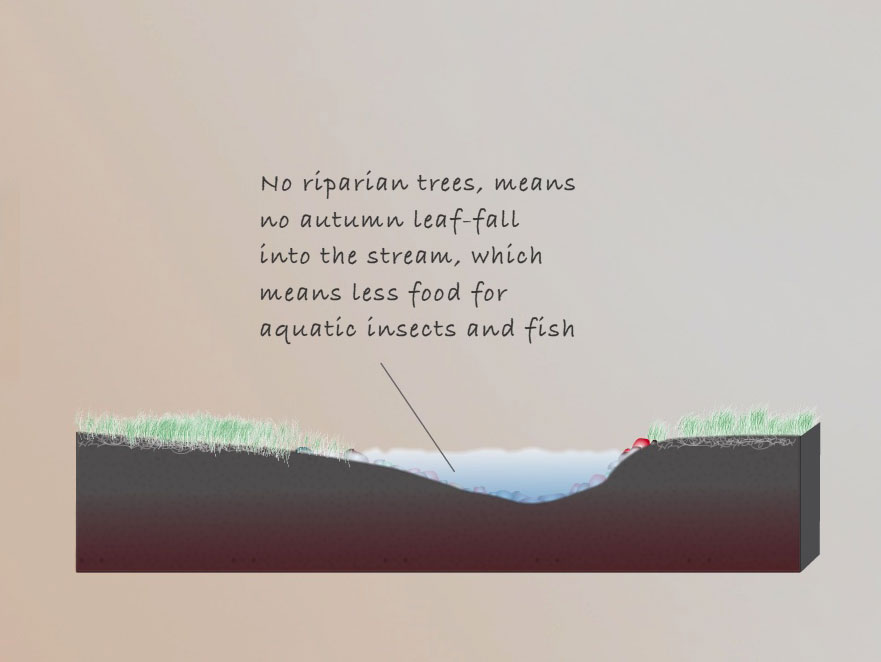
Use the bubbles to navigate between a stream with riparian cover and one without
During autumn, leaves drop into the stream. As they decompose, they are fed upon by aquatic insects. They, in turn, are the most important food source for fish and riparian birds. So a healthy riparian zone adds immensely to the productivity of the stream.
Leaves also fertilize the floodplain. As they fall and decompose, they release carbon, nitrogen, and other chemicals that nourish the soil and that tree roots can assimilate the following season.
Riparian vegetation supplies energy in the form of leaf litter and other organic debris, which is at the foundation of the aquatic food web.
When a riparian forest is converted to agricultural cropland or removed for other reasons, there is no autumn leaf drop, and that means a lot less food for aquatic insects and ultimately for fish and birds.
Riparian Cover: Stream Stability

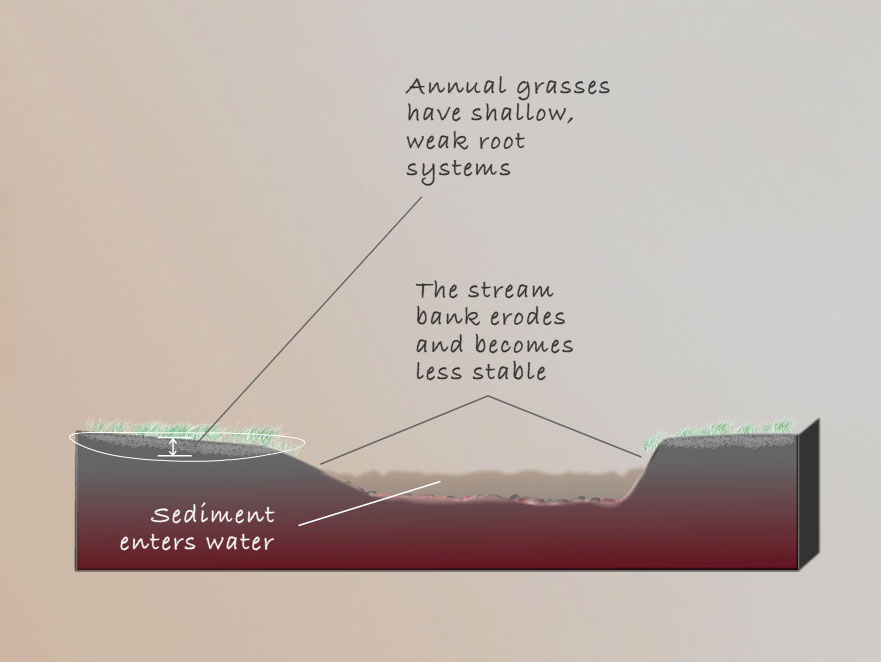
Use the bubbles to navigate between a stream with riparian cover and one without
Riparian vegetation is the most critical component of channel stability. The com-bined root masses of riparian trees, shrubs, forbs, and grasses are exceptionally strong and dense. Think of them as "riparian rebar". They work together to form a tight mesh that reinforces and holds stream banks.
Roots also increase the roughness of the channel, helping to dissipate the energy of floodwaters and catching and trapping sedi-ment so it does not fill downstream pools.
The loss of riparian forest cover means there are no roots to stabilize the stream bank, and that can result in erosion or downcutting—the stream cutting its way deeper into the bed and releasing sediment into the stream. The channel becomes less stable, and the increased fine sediment levels in the stream hurt trout spawning habitats by clogging streambed gravels. The sediment also fills in pools, and lowers aquatic insect production.
Riparian Cover: Water Temperature
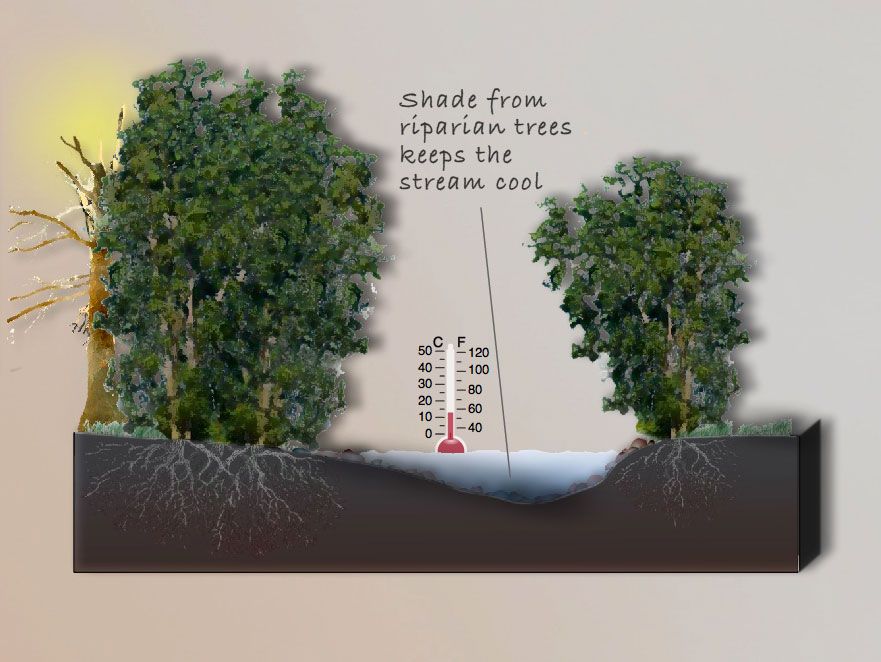
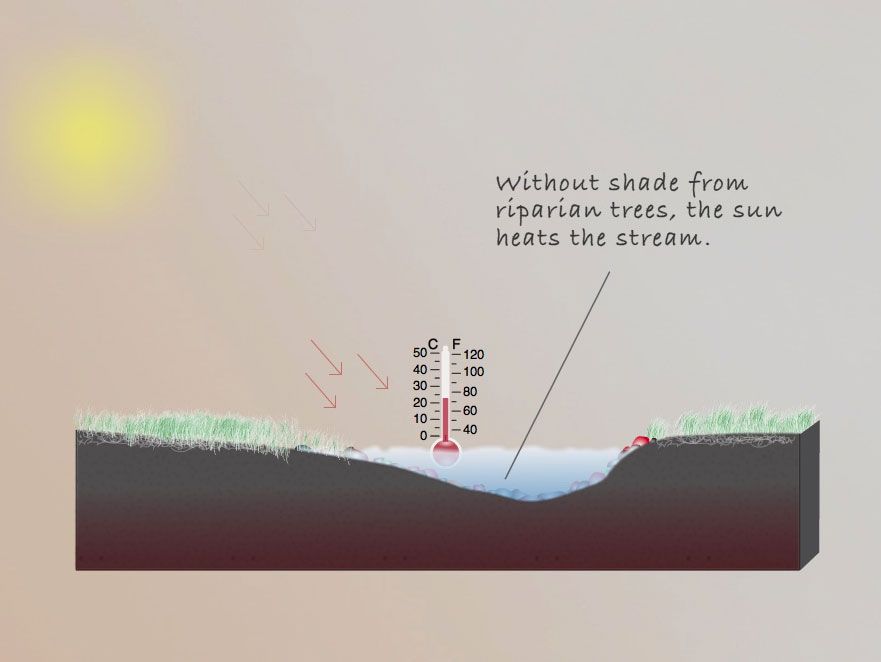
Use the bubbles to navigate between a stream with riparian cover and one without
The shade provided by riparian trees moderates local air and water temperatures and significantly reduces peak summer temperatures within the stream. Bull trout require cold water; they cannot tolerate maximum summertime water temperatures above 15° C (59° F).
Riparian forests will have an increasingly important role to play in limiting the effects of global warming on fish.
Increases in direct solar radiation caused by the reduction or loss of riparian vegetation is the single factor most responsible for high stream temperatures.
Fish biologists think the Jocko River is probably 5 to 10° F warmer today than it was in the late 1800s. Much of that increase is due to the loss of substantial areas of streamside riparian vegetation, trees and shrubs that once shaded the river.
Riparian Cover: Habitat
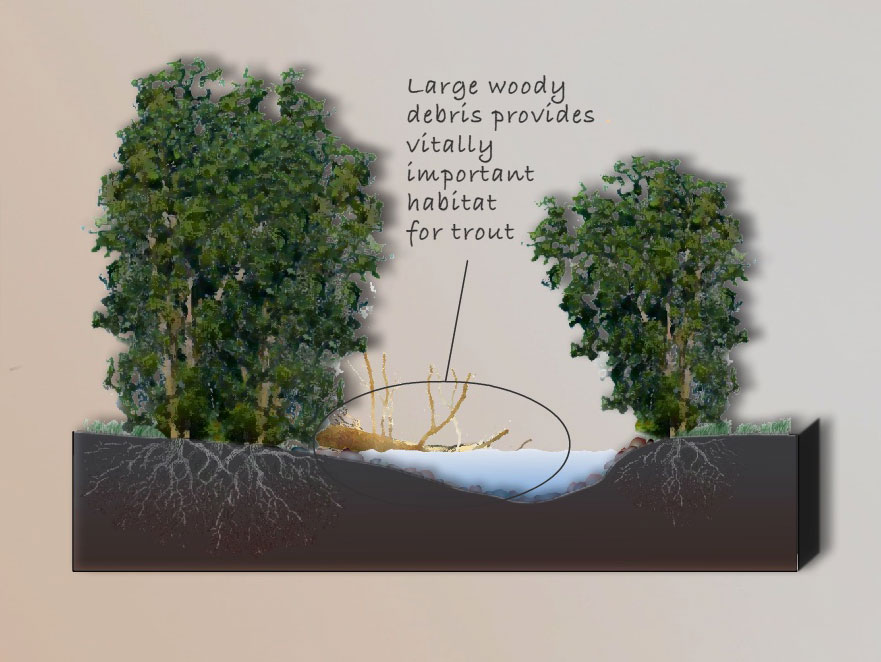
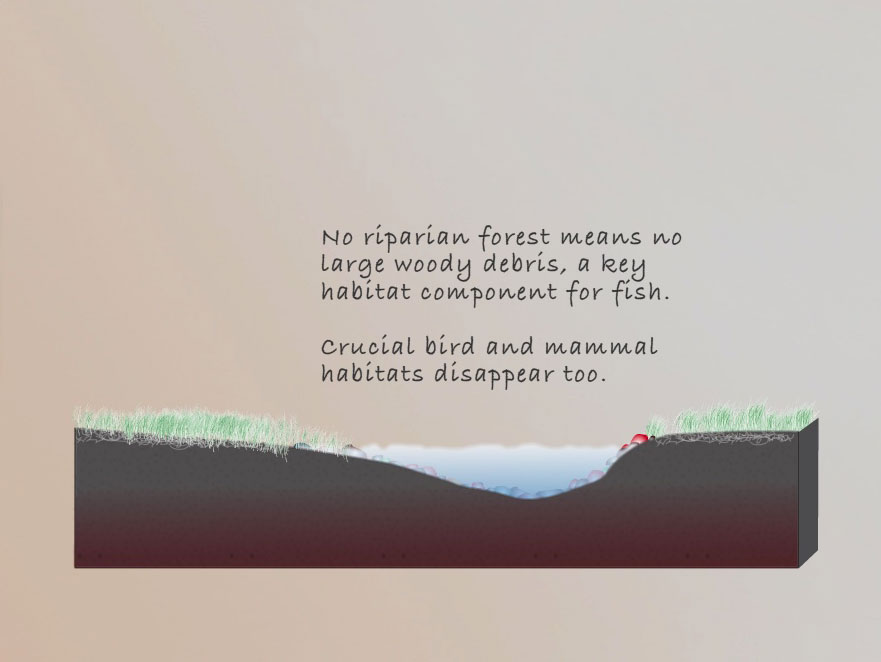
Use the bubbles to navigate between a stream with riparian cover and one without
Riparian areas provide a variety of important habitats for trout. Perhaps most important, they contribute large woody debris (logs) to the stream, which provides resting, hiding, and feeding areas for native fish. Tree roots of both standing and downed trees also provide important cover for juvenile trout.
In addition, riparian areas provide important habitat for birds and mammals. Three quarters of species in Montana use riparian habitats.
The removal of trees from riparian areas eliminates the source of large woody debris, which is essential to maintaining habitat complexity and productivity.
Grazing and trampling of vegetation by livestock can also damage habitats for fish and wildlife. The result is often wide, open channels with lower, warmer, and more turbid flows in summer; damaging ice conditions in winter; and flashier, more turbid flows during high-water periods in spring.
Riparian Cover: Water Quality
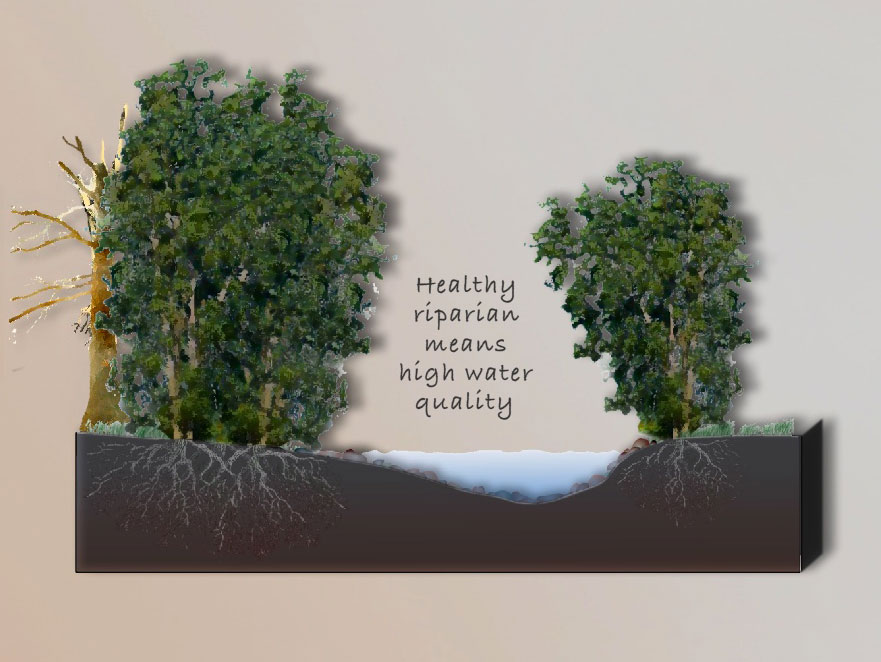
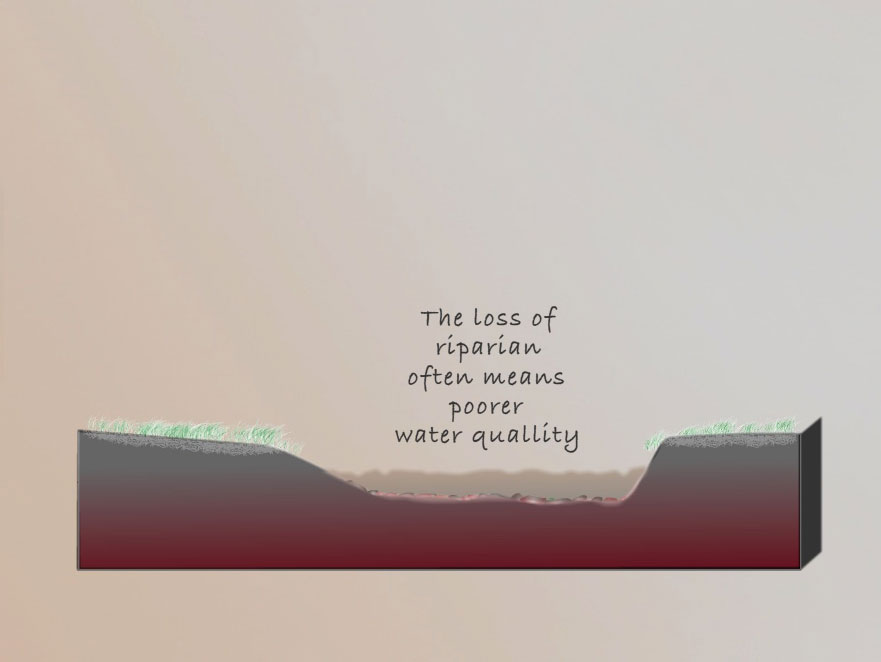
Use the bubbles to navigate between a stream with riparian cover and one without
Riparian areas protect water quality by capturing, storing, and treating water through their soils before it gets to the stream. Healthy growing plants take up nutrients transported into the riparian areas, and organic matter that drops from the riparian canopy onto the floodplain helps to capture contaminants and facilitate their breakdown.
Removing or reducing riparian cover by grazing, logging, or conversion to agricultural land will often lower the water quality of a stream. The effects of grazing can include trampling and sloughing of streambanks, loss of over-hanging banks, accelerated bank erosion, compaction of soils, and increased sediment input. Farming can increase erosion and sedimentation processes many-fold over natural rates. Logging can cause rapid changes in flow, increase peak flows, and increase sediment load (because the channel is less stable and eroding).
© 2021 Confederated Salish and Kootenai Tribes | Contact Us
© 2021 Confederated Salish and Kootenai Tribes | Contact Us